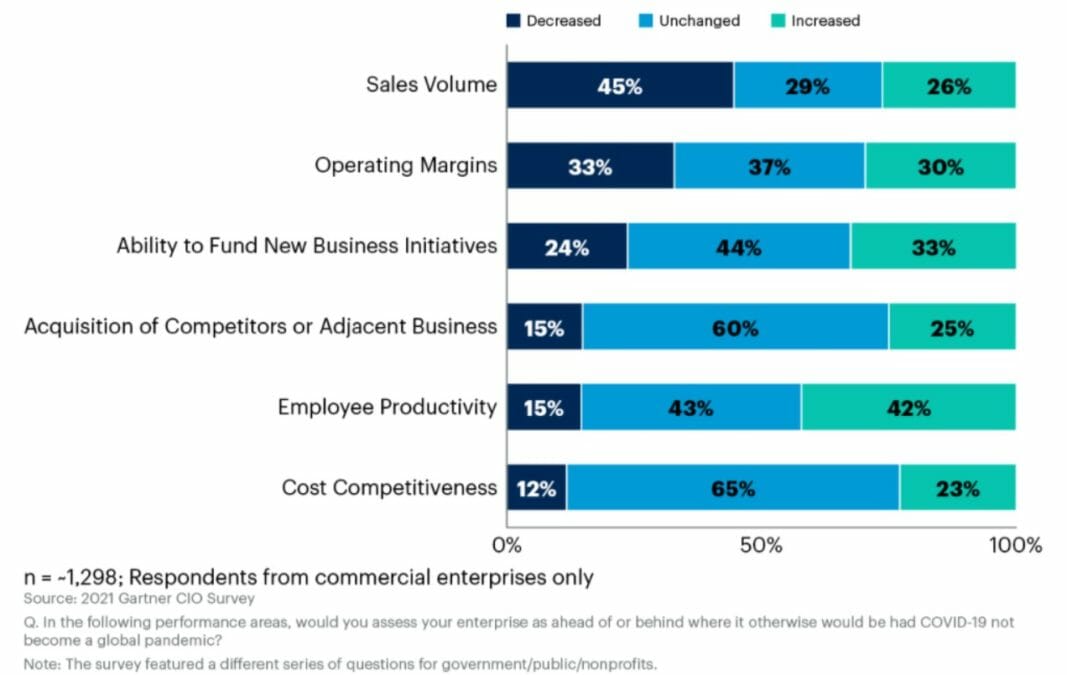The study, which was explored at Gartner IT Symposium/Xpo 2020 EMEA, revealed that the most successful CIOs and companies will be able to maintain the momentum they built up through effective digital innovation, during their response to the pandemic.
Gartner categorised CIOs into one of three sections: top performers; typical performers; and trailing performers.
Top performers rated themselves highly for digital maturity, business performance relative to competitors, and how advanced their post-pandemic response is.
Trailings, meanwhile, rated themselves poorly on digital maturity and relative business performance, and typicals represent the rest of – and majority of – respondents.
IT portfolio rationalisation: how CIOs are surviving economic turmoil
“Nothing, yet everything, has changed for the CIO,” said Tomas Nielsen, research vice-president at Gartner. “The support for remote work that the Covid-19 pandemic brought on might be the biggest win for CIOs since Y2K.
“They now have the attention of the CEO, they have convinced senior business leaders of the need to modernise technology, and they have prompted boards of directors to accelerate enterprise digital business initiatives.
“Delivering digital is, of course, paramount in today’s environment. However, there was already a new normal necessitating CIOs to accelerate digital business efforts across many industries.
“To do it well, CIOs should define what is meant by digital business acceleration and be clear on how to get it done. CIOs must seize this moment, because they may never get another opportunity like it.”
The 2021 Gartner CIO Agenda survey gathered data from 1,877 CIO respondents in 74 countries and all major industries (687 CIOs in EMEA), and found four ways in which CIOs can make a difference in digital business acceleration and long-term agility:
1. Win differently
CIOs can lead by helping to increasingly digital interactions expected by customers. 76% of respondents said demand for new digital products and services increased in 2020, while 83% reported that it will increase in 2021.
The use of digital channels to reach customers and achieve citizen engagement, and the rate of introduction of new digital products and services, were found to be key ways in which top performing organisations are achieving this; nine in ten are pursuing digital channels, while almost three-quarters are introducing digital products faster.
“This is a watershed moment for CIOs across the world,” said Nielsen. “There is no going back to the way business used to be.
“Those at the top have gone all-in on digital business, and they have developed the capabilities to allow them to do it.”
2. Unleash force multipliers
When asked to characterise certain changes related to enterprise IT leadership trends as a result of the pandemic, around 70% of CIOs said they deepened their knowledge of specific business processes to advise the business.
The same proportion of respondents, meanwhile, said they did more to measure and articulate the value of IT.
“Although the Covid-19 response appeared to be a simple exercise of deploying PCs, it created profound opportunities for CIOs,” said Nielsen.
“CIOs were able to refocus IT leadership around digital business acceleration and remodel the enterprise’s core technology. At one point or another, every CIO got a chance to shine during Covid-19.”
3. Banish drags
Finding and eliminating detrimental supplier performance, or drags, during Covid-19 can aid acceleration of digital initiatives, according to the Gartner survey.
While most respondents reported being behind in sales volumes during the pandemic, only 29% of top performers reported a decrease in sales volume, versus 45% of typicals and 62% of trailings.
However, some respondents reported increased performance for new business initiatives, acquisitions, cost competitiveness, and employee productivity.
When asked about shifts in demand, 58% of top performers reported an increase in demand from new post-Covid customers, versus 49% for the typical group and 37% for those trailing.

“Although revenue took a big hit, leading CIOs decided to fight back rather than go into a defensive crouch,” said Nielsen.
4. Redirect resources and get closer to consumers
EMEA CIO respondents projected a 2.7% IT budget increase for 2021, on average, which is the largest among the four regions.
32% of EMEA respondents said they will reduce spending on infrastructure and data centres, while 49% will increase spending on cloud technology.
77% of EMEA CIOs declared an increase in demand for new digital products and services to get closer to the customer. Additionally, 39% plan to increase spending on customer engagement in 2021.
Fintechs: transforming customer expectations and disrupting finance
“We have observed a shift in organisational spending towards IT despite a reduction in the overall budget. The pandemic crisis has accelerated it,” said Jan-Martin Löwendahl, distinguished research vice-president at Gartner.
“It’s both about ‘out with the old and in with the new’, such as moving from on-premise to the cloud, and an internal redirection of spending from HR and finance to IT.”
Changes in leadership
Due to the pandemic, the standing of IT in the enterprise has increased, according to the Gartner study.
“In 2021, CIOs must continue to be involved in higher-value, more strategic initiatives,” said Löwendahl. “The better CIOs perform for the business, the more the business will ask of them next year.”
The findings were explored at the Gartner IT Symposium/Xpo 2020 EMEA, which is taking place from the 9th-12th November.







